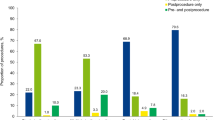Abstract
Scope and purpose
This aims to provide healthcare professionals, including primary care dental practitioners, with clear guidance on the management of patients who are taking oral anticoagulants and who need dental surgery.
Methods
Medline and Embase databases were searched from 1950–2006 using the following keywords: dental, surgery, oral and anticoagulants. The guideline was developed according to the guidelines of the British Committee for Standards in Haematology (BCSH), which can be seen in detail at www.bcshguidelines.com/process1.asp. The system for classification of evidence and grading of recommendations is shown in table 1.
Review and updating
BSCH indicate that updating review of the guideline is planned for 2011.
Recommendations
The guideline make 5 key recommendations which are shown in Table 2.
Research recommendations
None were given.
Similar content being viewed by others
Commentary
These guidelines were developed by the BCSH and, in addition to being published in the British Dental Journal,1 are available on the web (www.bcshguidelines.com/pdf/WarfarinandOralSurgery26407.pdf). The number of people living in the community who take anticoagulants is on the rise and, as dental extraction is the most common surgical procedure, the need for clear guidance on managing these individuals is important. Indeed, as the guideline points out, there has been a good deal of historical controversy over how best to manage them.
The recommendations are based upon the balance of risks between continuing anticoagulation and postoperative haemorrhage and thrombosis. These are clearly in favour of continuing anticoagulation: there is a 1% risk of serious embolic complications including death but only a 0.2% risk of major bleeding for patients with a therapeutic INR <4. The dental practice procedures which require measurement of the INR are shown below:
-
Endodontics (root canal treatment)
-
Local anaesthesia (infiltrations, inferior alveolar nerve block, mandibular blocks)
-
Extractions (single and multiple)
-
Minor oral surgery
-
Periodontal surgery
-
Biopsies
-
Subgingival scaling
The guidance also recommends two particular groups of patients who should not have surgical dental procedures in the dental practice setting, namely:
-
People taking oral anticoagulants who also have co-existing medical problems, eg, liver disease, renal disease, thrombocytopaenia or who are taking antiplatelet drugs. Such patients may have an increased risk of bleeding.
-
Patients requiring surgical procedures not listed above. Such patients should be referred to a dental hospital or hospital-based oral and maxillofacial surgery department.
Although not described in the guideline or the BDJ publication,1 the BCSH does have a clear process for the development of guidelines and these are laid out on their website (see above). The process appears to fall short of the AGREE (Appraisal of Guidelines for Research and Evaluation; www.agreecollaboration.org) standards, however, as there is a lack of detail in the document or the website regarding various elements in the process. There is neither clear indication of the criteria for inclusion of the articles nor how they were appraised. Despite the guideline being authored by three people and being approved by the BCSH, there is no indication of the contribution of potential stakeholders (general dental practitioners, oral surgeons, general medical practitioners, patients, haematologists, etc). The guideline was circulated to a large group for comment prior to final publication but no information is given about the comments or changes resulting from this.
Many of these process issues may have been carried out but, because they are not dealt with in the documentation or on the website, uncertainty results. Some will say that including these additional details is unnecessary when what is needed is clear, unequivocal recommendations — which this guidance delivers — but providing the additional detail does better enable the reader to judge the quality of the development process. Well-funded national guidance development groups such as NICE (National Institute of Health and Clinical Excellence) and SIGN (Scottish Intercollegiate Guidelines Network) do this and the quality of their products is recognised.
It worth noting that the imminent NICE guidance, currently in the consultation draft (www.nice.org.uk/guidance/index.jsp?action=download&o=38152), recommends, “Antibiotic prophylaxis against infective endocarditis (IE) is not recommended for patients at risk of IE undergoing dental procedures”: the second recommendation of the BCSH will become superfluous if, as anticipated, the NICE recommendation is not amended.
That said, the guidance is relatively straightforward and highlights the key issues when managing patients taking anticoagulants. It also accords with what is taught in most dental schools and what, in discussion with general practitioner colleagues, they say they currently practice. For those wanting more detailed background information and practical information, I recommend looking at the North West Medicines Information Centre document which is available on the web (www.ukmi.nhs.uk/med_info/documents/Dental_Patient_on_Warfarin.pdf) which was last revised in March 2007.
References
Perry DJ, Noakes TJ, Helliwell PS . Guidelines for the management of patients on oral anticoagulants requiring dental surgery. Br Dent J 2007; 203:389–393.
Author information
Authors and Affiliations
Additional information
Address for correspondence: The Secretary, British Society for Haematology,100 White Lion Street, London N1 9PF, UK. E-mail: bcsh@b-s-h.org.uk
A randomized trial of the effectiveness of home visits in preventing early childhood caries. Community Dent Oral Epidemiol 2007; 35:215–223.
Rights and permissions
About this article
Cite this article
Richards, D. Guidelines for the management of patients who are taking oral anticoagulants and who require dental surgery. Evid Based Dent 9, 5–6 (2008). https://doi.org/10.1038/sj.ebd.6400558
Published:
Issue Date:
DOI: https://doi.org/10.1038/sj.ebd.6400558
This article is cited by
-
Managing dentoalveolar surgical procedures in patients taking new oral anticoagulants
Odontology (2015)
-
Access to special care dentistry, part 5. Safety
British Dental Journal (2008)



